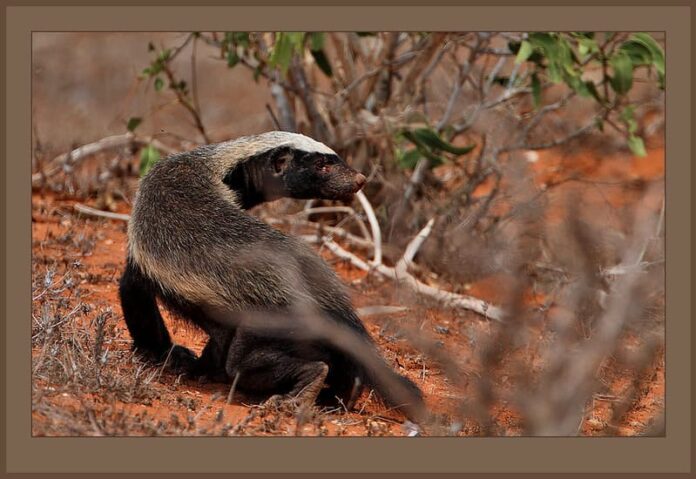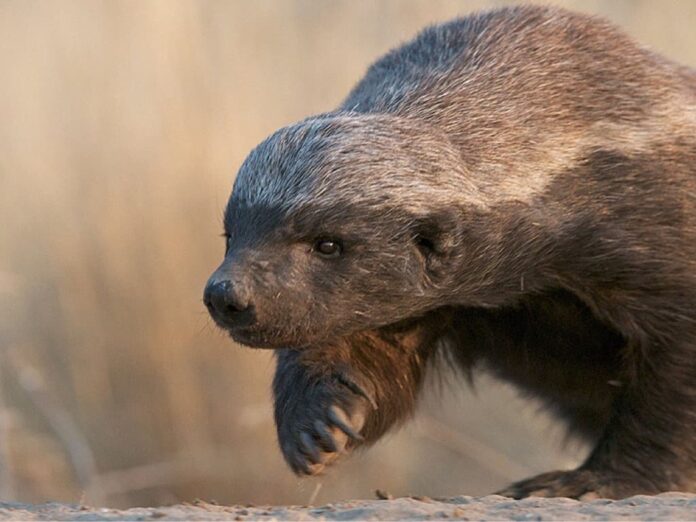Honey badger is one of the ferocious animals that we should always watch out for and should never mess with. What makes this mammal so deadly when we humans have destructive weapons to take it down, right? Things are not that simple during the encounter, and one does not simply want to battle a honey badger. Honey badgers are one of the toughest animals on Earth, and there are many interesting things about them. Although they prefer to avoid contact with humans, they are not afraid to attack if need be. The good thing is that there are no certain human death reports yet, and we should keep it that way. You probably already know a lot about this dangerous animal, so let’s see if there is anything new below.
1Appearance

The resemblance is uncanny if you look at a honey badger and a skunk, except the honey badger is more badass. A honey badger has a long body with short powerful legs, standing about 12 inches at the shoulder. Its whole body is covered with extremely thick and tough skin that most fangs, quills, and stingers cannot penetrate. Its hair is also coarse and thick, mostly black with a wide gray-white stripe that stretches from its head across its back to the tail. The honey badger can survive a bite from a king cobra, and eat the snake after their brawls. A honey badger has a small and flat head with a short muzzle, and they have small eyes. They have small ears that look like tiny ridges on the side of their heads. It is a part of adaptation to avoid damage while fighting.
The most fascinating part is that they have extremely powerful teeth that can break the shell of a tortoise. A bite from a honey badger is not pleasant, and the fact that they are immune to snake venom makes them even more appalling. Honey badgers can handle bites from even the world’s deadliest snakes like cobras, mambas, and puff adders. On their hands are long claws that help them to dig burrows to build shelters in the ground, tree trunks, or termite mounds. Those claws are so sharp and strong that the honey badgers can capture prey hiding underground within minutes. Another interesting thing about them is that they can turn their anus inside out to spray stinky liquid. Similar to a skunk, it can shoot a foul-smelling liquid that buys them some time to escape. They use this pungent smell to intimidate their rivals and mark their territory.
2Behavior

More often than most, violent animals are not always smart; but things are different with honey badgers. They are able to trick captors or use tools that they can find in order to escape from man-made traps. These animals are fearless, and the fierceness to attack and pick a fight with others runs in their blood. Picking a fight with porcupines is what thing, but attacking lions is another thing to reckon about these little beasts. The sharp claws and teeth help them to defend themselves in a battle, and they never back down from a fight. Sometimes they bluff by charging and growling to intimidate the predators, and it works almost every time. People always think that honey badgers are mean, but it is not like that. They only attack to defend themselves, and they are not aggressive with those who do not harm them.
Honey badgers are solitary, and they most of the day curling up into a ball to protect their belly and face. When they are alone, they spend most of their time actively and noisily patrolling their territories while searching for food. Honey badgers only come together to mate during the breeding season, so they live alone for almost the whole year. Sometimes they do hang out with a partner during mating season for a month before taking their solitary path once more. Female honey badgers have two pairs of breasts with nipples that help them to nurse multiple young. Since it is very common for them to give birth to twins, they are able to care for both equally. Young honey badgers often stick with their mothers as long as it takes, and they decide when they want to leave.
3Feeding & Habitats

Honey badgers are cathemeral which means they can be active both day and night. These sweet-tooth animals love feeding on honey and honeybee larvae, and this is also how they got their name. Those are special treats, but they normally eat berries, bulbs, fruits, and roots. Since they are omnivores, honey badgers also eat amphibians, birds, insects, mammals, and reptiles. These ferocious mammals hunt for their own food most of the time, but they are also opportunistic animals. So they will scavenge the kills of bigger animals of steal from other carnivores if the situation is favorable. Thanks to their prominent sharp teeth and long fore claws, no meat is too tough for them to rip apart.
These badass animals are native to areas of Africa and Asia, living in different conditions and environments. As hardy animals, honey badgers can adapt to a wide range of conditions when it comes to habitats. From cool mountains to rainforests, honey badgers can live in them all as long as there is food for them. In those areas, they live in abandoned dens of other animals, rock crevices, or tree hollows. Since they are also great climbers and swimmers, moving from one place to another is not a problem for them.
4Predators & Threat

The foes of the honey badgers in the wild are hyenas, leopards, lions, and pythons. A honey badger’s skin is 6 millimeters thick which is thicker than almost all other animals. The skin is extremely thick for its small size, and even arrows and spears cannot pierce through. More than that, the rubbery epidermis is loose enough for it to writhe around and break loose from an enemy’s jaws. But what they have is not tough enough to protect themselves from the main predator, humans.
Being strong in the animal kingdom does not help them from being vulnerable to human hunting. People hunt them for their meat and other uses in the traditional medicine trade. In certain regions, people also persecute them due to their affray with beekeepers and farmers. Honey badgers are considered endangered in parts of their range due to food supply reduction and human encroachment. Along with those, many of them also die from accidentally consuming poisons made for jackals. Their population is still declining although there are conservation and protection in some regions.
Related Post: Lamprey The Vampire Fish




